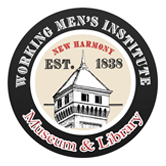Contact Us
September 17, 2015WMI Board of Trustees
March 25, 2018The Archives
The archives of the Working Men’s Institute are divided into two sections – the Branigin Archive and the Lilly Archive. The Branigin Archive houses manuscripts from the Harmonist and Owen communal societies established at New Harmony, 1814-1827. It also contains items from the close of the Owen community in 1827 up to the present day including materials from the “after-glow” period when New Harmony was known as the “Athens on the Wabash” (1827-1900). Besides manuscripts, the Branigin Archive houses books on New Harmony and related subjects.
The Lilly Archive is the repository for our rare book collection. It contains books from the libraries of William Maclure, David Dale Owen, Richard Owen, Robert Dale Owen and other important figures from New Harmony’s past. Starting with our oldest publication, which dates to 1538, the books housed in the Lilly Archive are the finest in science, literature and history found in their day.
Search the Archives
The archives are searchable in the following ways. Use the online catalog. If BSC is before the call number, the item is found in the Branigin Archive. If SC appears before the call number, the item is located in the Lilly Archive. For items in the Branigin Archive consult the online finding aids.
Finding Aids
Each year, portions of the documents housed in the Branigin Archive are digitized. This has been made possible by funding from the LSTA Grant Program. Along with a searchable finding aid, the documents themselves are available online.
For series or collections not yet digitized, an online finding aid is available.
New Harmony Series
The New Harmony Series was first cataloged in the 1950s by Dr. Arthur Bester. Material was added in the 1970s by Josephine Mirabella Elliott. The remaining materials were cataloged in the last few years. The series are as follows.
Series I New Harmony Correspondence
Finding aid and letters digitized. Letters concerning the New Harmony Community range from 1812-1871. Many are from key people in the Harmonist and Owen communities at New Harmony.
